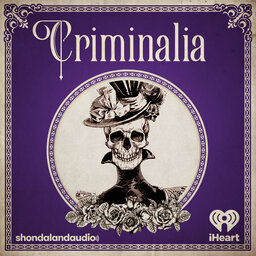Welcome to a New Season of Criminalia: The Forgers
Some estimates suggest that as much as 50 percent of all artwork on the market today is likely forged or misattributed. It can be difficult to verify what is authentic and what is counterfeit, from art to music to archaelogical findings. In this new season, we'll talk about who makes these fakes.
Executive Producers: Maria Trimarchi and Holly Frey
Producer & Editor: Casby Bias
The Italian Renaissance sculptor, painter and architect who gave us the Statue of David and the Frescoes and the Sistine Chapel, once faked a Roman antique when he was a young and relatively unknown artist. That's right, Michaelangelo's inauthentic marble sculpture of the Sleeping Arrows was sold to Cardinal Rafael Riario in fourteen ninety six, and way before that, in the fifteenth century BCE, Greek sculptor Phidias is said to have signed works of his talented students. Another form of forgery. Fakery has been going on for a long long time, and sometimes in surprising ways and from surprising sources. Welcome to a brand new season of Criminalio where we'll be talking about forgeries and the forgers behind them throughout history. I'm a range from Marquee.
And I'm Holly Frye. Forgery is a crime, and legally speaking, it's a crime committed when a person either alters or creates a legal instrument with the intent to defraud, and that term legal instrument can mean a lot of things, including forged records and signatures, currency, art, literature, music, archaeological findings, stamps, and everything in between.
The Fine Arts Expert Institute in Geneva estimates that as much as fifty percent of all artwork, and that's just artwork currently on the market today may be forged or misattributed. It can be really difficult to verify what is authentic and what does counterfeit. And though that number is only an estimate, forged antiquities are actually and unfortunately pretty common in museums and private art collections. We'll talk about who makes these fakes, and we'll talk about people like agents on the FBI's Art Crime Team who investigate this type of fraud.
From counterfeit miracles to faking the Day of Jack the Ripper. This season is full of knockoffs, phonies, and imitations of all kinds. We'll be telling stories like these Han von Nigern, who wanted to be a real artist, but critics kept calling his work highly derivative, so instead he took up forgery as his career and became one of the greatest art forgers of all time.
And we'll also tell the story of Joseph Cosey, a forger who was highly skilled at mimicking the handwriting of historical American figures. He forged signatures, as well as entire letters and manuscripts of such persons as George Washington, James Monroe, and Mark Twain.
And then there is a long history of music works that are attributed to one composer but actually are written by a forger. Take, for instance, the Adelaide Concerto by Volsgang Amadeus Mozart, attributed to the maestro, but actually composed by Marius Kazatsu. And that is just a small taste from a variety of forgery examples will get into you.
So, just like other seasons, there's no wait. We're rolling straight from a world of accelerants and fiery destruction to one of fakes and counterfeits and the forgers who made them. We'll see you there, not only with some very real stories about some very fake things, but also with the cocktails and mocktails made to go with them.
Join us on Criminalia for a new season of fakes, phonies, and counterfeits and the forgers behind the starting August fifteenth, on the iHeartRadio app, Apple Podcasts, or wherever you listen to podcasts.
 Criminalia
Criminalia


